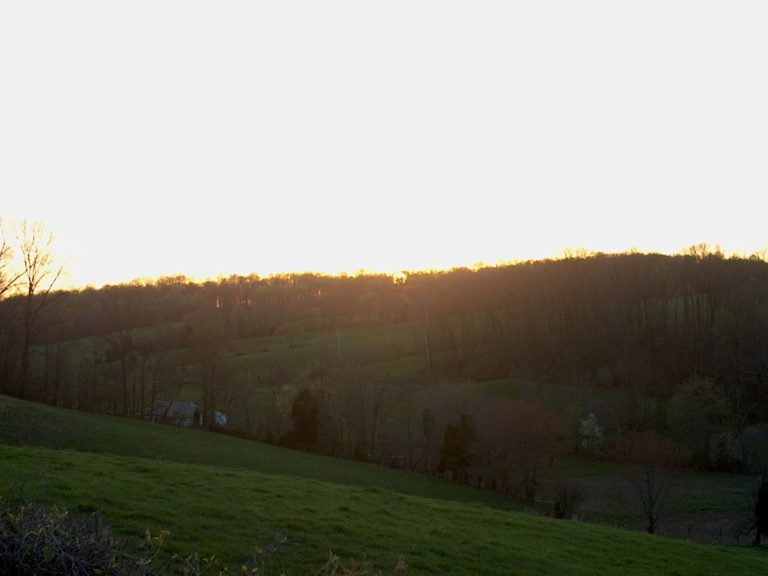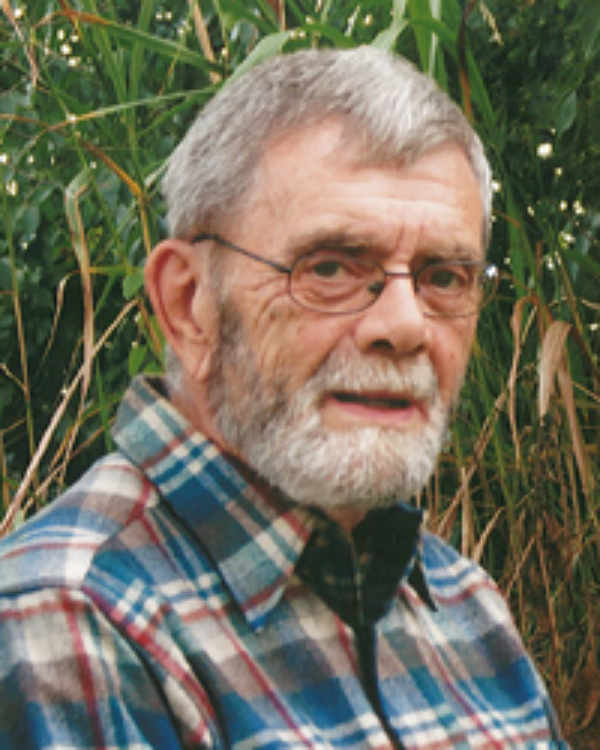
Sunset in St. Meinrad. Image by Garden Beth/Flickr (CC BY-NC 2.0)..
A Sacred Place Underfoot
My town is like all small towns lying in a river valley protected by hillsides from sunrises, sunsets, and people. The place is insignificant like many places. I didn’t know it was sacred.
The town began about 450 million years ago. We had warm weather and shallow seas and cruise ships could have docked at my front door. During the passing eras tens of thousands of species of animals swam, crawled, drifted, made babies, and died. Some of them are still here sealed in stone.
The Mound Builders were not active around my town. A few arrowheads, perhaps, but nothing to write the museum about. They must have left behind objects sacred to them, but we don’t know what we are looking for.
Indians lived in a village on the flood plain behind the train depot. They must have been Shawnee because we have the Shawnee Bowling Alley, Shawnee Apartments, and Shawnee Drive-Thru. I hope for a fitting remembrance. The Shawnee worshiped the Creator. She is making a net and one day will sweep it across the world and gather her children and take them home with her.
There are four graves of Revolutionary War veterans near the gazebo in the town park. We have sent away our young men to the wars for two hundred years. They went off to see the world and change it. They came home with these worlds in their pockets, changed. Not far from town the Shakers built a village. They invented clothespins and built chairs as if the chairs were the first in the world and as if they were the last. They built them, they said, so angels could sit on them. They danced and sang wildly, praising God (the tools of the farmer and the carpenter were tools of the altar) and took their wares to sell at Saturday’s market and returned home, leaving behind the Shaker spirit.
My Aunt Lois, who was young when the Shakers were old, remembered that the Shakers allowed ice-skating on their frozen ponds in the winter. “But never on Sundays,” she said. The Shakers lived with one foot planted firmly in heaven and the other planted firmly in the fields and sang until the one caught up to the other. There was a time not long ago when taverns outnumbered churches in my town. Times changed. Churches won.
About fifty years ago I help my Uncle Ed plant a white ash tree in the back yard. The tree and I were the same size. Now the fifty-foot tree is a landmark on our block and I was there at the beginning. His trees had to have a reason: persimmon for the squirrels, mimosa for its gossamer blossoms and; and the gingko because it is the oldest tree on earth. Uncle Ed planted trees that he would never see in full, magnificent maturity. “They are not for me,” he told me.
We had an earthquake once. Small, very small, just a few rattling dishes. Once, a tornado took out a few trees and houses. There were floods as happens to towns built along a river. And there have been broken limbs and hearts, quiet passings and screaming cancers, hopes and dreams accomplished and stillborn; and behind doors abuse and abortions and untold things. We survived them all.
Every morning as I delivered newspapers from my bicycle I saw Mrs. Kater walk to early Mass at the Catholic Church. Every day. Perhaps she thought the town was her monastery.
I remember a man who stood in front of the A and P with a German Shepherd at his feet and a white cane in one hand and a tin cup in the other. He rattled the tin cup and people put money in it. And the end of the day he put his collection into an envelope and dropped it in the mailbox of a local church. He wasn’t blind.
Knowles Shaw, the minister who wrote the gospel hymn “Bringing in the Sheaves” and many others lived in my town. He was known as the “Singing Evangelist” throughout the Midwest in the late 19th century. He baptized more than 20,000 people. The church next door to his house tore it down and built a parking lot. But we still have “Bringing in the Sheaves.”
I remember a lady in a wheelchair who lived on a small Social Security check and on what she earned writing stories for the local newspaper (three cents a word). I only write good stories about happy people, she said. She wrote many stories.
There was an undiscovered lady who in the stealth of night inspected flower gardens in my town. She weeded and pruned and snipped and cut. If she though your clump of daisies were wrongly placed or red geraniums did not go with pink petunias she moved them to her liking and taste. She carried out her self-assignments beautifully and brought harmony to where there was none before.
In summer church basements were crowded with church suppers. Chicken and roast beef dinners served by neighbors to neighbors. The aromas of frying chicken and sage and spices and apple pie rose from basements like incense.My priest told me that a place is made more holy by the prayers said there. I believe that a place is made more sacred by the people who lived there.
I heard that a tree has a spirit; a stone absorbs the sounds around it; and a house retains within its walls the love, joy, and grace that thrived there. If this is true, my town is a place most sacred, like so many places in the world.

Share your reflection